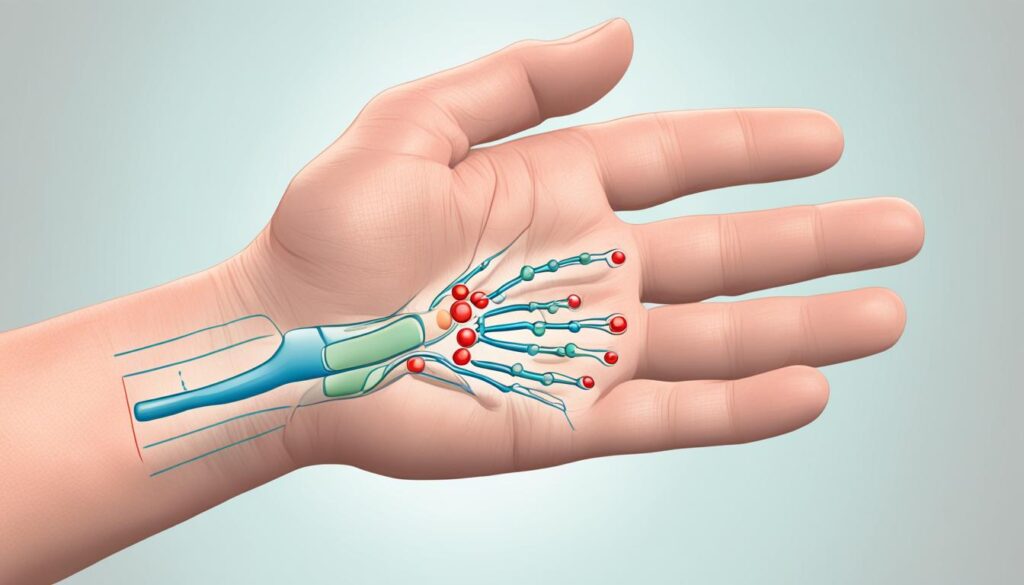Nausea and vomiting can hit anyone. They’re not just symptoms of pregnancy. They can occur due to motion sickness or other causes. Rather than solely relying on anti-nausea drugs, many people look for and home cures. This article will highlight several ways to reduce nausea and vomiting. It includes using ginger, peppermint smells, acupuncture, breathing exercises, changing your diet, and more. Our aim is to give a complete outline of what helps manage these feelings. We cover both home methods and medical options. The goal is to help you find the best way to ease your symptoms.
Table of Contents
ToggleUnderstanding Nausea and Vomiting
Causes and Symptoms
Nausea makes you feel like you’ll throw up. Vomiting means your stomach contents come out through your mouth. There are many reasons why this can happen. It might be because of motion sickness, bad food, migraines, being pregnant, or certain drugs. People feel stomach pain or like they need to vomit. In serious cases, this might cause the body to lose too much water or have problems with minerals.
When to Seek Medical Attention
Most of the time, you can handle nausea and vomiting on your own. You should see a doctor if the problem is serious, you vomit a lot, you can’t drink any liquids and you begin to feel thirsty, you have strong stomach pain, or you have other symptoms like a fever, spinning dizziness, or find blood in your vomit. It’s even more critical for kids, older adults, and people with certain health issues to get help. A doctor can check you out and help figure out the best way to treat it.
Ginger: A Natural Remedy
Ginger is known for easing nausea and vomiting. It contains active compounds like gingerol and shogaol. These might work like anti-nausea drugs by impacting the brain and nerves to lessen nausea. Many studies have shown ginger is effective against nausea from various causes, including pregnancy, travel sickness, and chemotherapy.
How Ginger Works
Ginger’s active ingredients, like gingerol and shogaol, may calm the digestive and nervous systems. This could reduce the feeling of sickness. By helping the digestive system and stabilizing blood pressure, ginger might lower how much you feel like throwing up.
Recommended Dosage
The right amount of ginger for nausea isn’t clear. But, around 1,500 mg a day might help, according to some research. You can have ginger fresh, in your tea, or as a supplement. Always read the label on supplements and don’t take too much to avoid heartburn.
Safety Considerations
Ginger is safe in usual food amounts for many people. But, taking a lot of ginger supplements might not be safe, especially in certain health conditions or with some medicines. If you’re pregnant, it’s a good idea to check with a doctor before using ginger supplements. Even though ginger is a pretty safe remedy, it’s always wise to be careful and stick to the right doses.
Peppermint Aromatherapy for Nausea Relief
Peppermint aromatherapy might reduce feelings of sickness. Studies show breathing peppermint oil or using a peppermint inhaler helps. This is especially true for those getting chemotherapy. The menthol in peppermint soothes the stomach. This can ease sickness.
Drinking peppermint tea might also help fight sickness. But, we need more studies to be sure.
Smelling peppermint oil can make you feel less sick if you’re on chemo. It’s also great for pregnant women who feel nauseous. Peppermint aids digestion. For this reason, it cuts down on feeling sick or having a hard time digesting.
If you’re worried about nausea, peppermint is usually a safe option. But, it might give you heartburn or a stomach ache. If you’re very sick or pregnant and it’s not going away, see a doctor. Peppermint eases muscle tension, calms nerves, and improves digestion. This makes it a good way to battle or avoid feeling sick.
Acupuncture and Acupressure
Acupuncture and acupressure come from ancient Chinese medicine. They aim to reduce feelings of sickness and the need to vomit. The idea is that by touching certain spots on the body, it activates the nervous system to lessen these symptoms. Research shows that working on the inner wrist at a points called P6 or Neiguan can help. It’s good for sickness from treatments, operations, and when expecting a baby.
Understanding the Principles
Acupressure is like massage from Chinese acupuncture. It makes the muscles less tense and boosts blood movement. This can cut down how often you feel sick or throw up after chemo. When you press on a spot near your wrist, called P-6 or Neiguan, it can make you feel less sick and stop you from throwing up.
Locating the P6 Point
The P6 point is easy to find. It’s on the inner arm, a bit down from the wrist’s crease. Just use your thumb to press gently but firmly on it for a bit. Then, do the same on the other arm. This easy method might help with sickness.

Citrus Scents: A Refreshing Solution
Inhaling the scent of lemon can make you feel better when you’re sick to your stomach. A study showed that pregnant women with lemon smells felt 9% less sick. This gentle smell seems to make our minds feel more at ease, which fights off stomach sickness.
Keeping a fresh lemon or some lemon oil nearby offers a simple way to enjoy the lemon for nausea benefit. It refreshes and relaxes you, making those queasy moments easier to handle.
Breathing Exercises for Nausea Management
Learning to control your breath can really help with nausea. Studies prove slow, deep breaths can lessen nausea and vomiting from treatments like chemo. These breathing exercises for nausea make your body calm, reducing sick feelings.
Controlled Breathing Techniques
Inhale for three seconds through your nose, hold it for three, and then breathe out through your mouth for three. This method of deep breathing for nausea can ease your mind and body, making discomfort lessen. Make this simple, regular deep breathing part of your day to help cope with nausea.

remedies for nausea and vomiting
Spices like Fennel, Cinnamon, and Cumin
Besides ginger, other spices might help with nausea. Fennel powder can lessen upset stomachs. Cinnamon might make nausea from periods less severe.
Cumin extract may help with gut issues like pain, bloating, and diarrhea. It’s good to know these spices can help at home. But, using them needs care due to the high amounts often tested.
Recommended Dosages and Safety
Studies suggest taking 180-420 mg of fennel, cinnamon, or cumin per day for nausea could be helpful. However, these amounts are hard to get from everyday cooking and may not be safe for everyone.
While spices like fennel, cinnamon, and cumin are safe for most people, too much could cause issues. Always check with a doctor before taking big doses of these spices, especially if you’re unwell.
Muscle Relaxation Techniques
Relaxing your muscles helps combat nausea too. A method called Progressive Muscle Relaxation (PMR) is used for this. It involves tightening and then releasing muscle groups across your body. This helps your body and mind calm down. PMR has been shown to lessen chemo-related nausea. By relaxing muscles, it makes your body feel less stressed, easing nausea.
Progressive Muscle Relaxation
Progressive Muscle Relaxation (PMR) is a great tool for managing nausea. This technique has you tighten and then loosen muscles in a specific way. It leads to both physical and mental calmness. Studies show PMR decreases the severity of nausea in chemotherapy patients. The technique’s muscle release can significantly cut down on body tension, making nausea easier to bear.
Massage Therapy
Massage therapy is another aid for nausea. A study in 2020 discovered that foot massages lower nausea and vomiting during chemo. The calmness and relaxation from massages cut muscle stress. This can help you feel better, reducing nausea. Adding massage to your nausea-fighting plan, as shown on MedicineNet, is a smart move.

Vitamin B6 Supplements for Pregnancy Nausea
If you’re pregnant and feeling sick, vitamin B6 could help without the risks of some medicines. Studies say taking up to 10-25 mg of vitamin B6 three or four times daily might lessen nausea during pregnancy. Vitamin B6 seems safe for pregnant women, with few side effects known. But, we still need more research to know the best dose of vitamin B6 for morning sickness more strongly.
Dosage and Safety during Pregnancy
If you’re expecting, talk to your doctor before starting any new supplement, like vitamin B6. They can help you choose the right safe vitamin B6 dosage for you. Though Vitamin B6 is thought to be safe, it’s crucial to stick to the dose your doctor suggests and watch for side effects.
Dietary Modifications
Making changes in what you eat can ease nausea. Try eating plain, easy-to-digest food like bananas, rice, and applesauce. Avoid greasy or spicy food as it might make nausea worse.
Smaller, Frequent Meals
Eating little and often can also help with nausea. Big meals can make it worse. So, try to eat small amounts more frequently.
Hydration and Electrolyte Replacement
If you’re throwing up, keeping hydrated is key. Drink water, broths, or sports drinks to replace lost fluids and electrolytes. Staying hydrated can reduce nausea, especially if you’re vomiting a lot.

Physical Activity for Nausea Management
Being active can help manage feelings of nausea. Research shows that activities like yoga reduce nausea, especially in pregnant ladies and people with cancer. The gentle movements and focused breathing can calm the body. This process eases nausea. Adding light movements to your day, if it’s okay for you, is a smart way to cope.
Yoga and its Benefits
Yoga, focusing on exercise for nausea and mindfulness, is excellent. It uses slow movements and deep breaths to relax. This can help lessen how often you feel nauseous. Doing yoga often has even helped lower nausea for pregnant women and cancer patients.
Using yoga for nausea and light exercises can put you in control. Listen to your body, and only do what you can. Too much can make nausea worse. So, go easy and find what works for you.
Antiemetic Medications
This article has mainly looked at natural ways and home remedies for nausea and vomiting. Yet, there are medicines to help too. Doctors can give you antiemetic drugs to help lower nausea and stop vomiting. These drugs include serotonin and dopamine antagonists. They also have neurokinin-1 receptor antagonists. They work well for different sicknesses that cause nausea and vomiting.
Types and Side Effects
For nausea you can buy Bismuth subsalicylate (known as Kaopectate and Pepto-Bismol). Antihistamines like dimenhydrinate (Dramamine) and meclizine (Dramamine Less Drowsy) are also good. Bismuth subsalicylate helps with nausea, vomiting, and stops diarrhea too. Antihistamines are best for motion sickness. They stop your brain from getting messages that make you sick.
But, these drugs can make you tired, give you a headache, or make you constipated. Bismuth subsalicylate might turn your tongue or stool dark. It could also cause constipation or make your ears ring. Antihistamines might make you very sleepy, especially when mixed with alcohol. This could be dangerous if you’re driving. Older people or those with health problems face a higher risk of side effects.
When you think about taking medicines for nausea, talk to your doctor. Bismuth subsalicylate can change how other drugs work. The list includes blood thinners, gout meds, arthritis meds, and diabetes pills. You should avoid giving Bismuth to kids under 12 with flu or chickenpox due to a rare risk. Remember to keep these medicines in a safe place, cool and dry, and away from kids.

Staying Hydrated
Proper hydration is key when you’re feeling nauseous, especially if you’re throwing up. Lack of fluids can make nausea worse and cause more problems. Try to drink clear, cold liquids like water or broths. Also, electrolyte-rich sports drinks are good to replace lost fluids from vomiting. This helps reduce nausea and keeps other issues, like not having enough electrolytes, at bay.
Not drinking enough shows through feelings of thirst, dry lips, less bouncy skin, and urine that’s darker than usual. To keep this from happening, drink water often, but stay away from very cold drinks. Also, eat foods that can help with hydration. Warning signs to watch out for include vomiting or diarrhea that won’t stop, a fever with nausea, not thinking clearly, or severe dehydration symptoms. In these cases, it’s vital to see a doctor right away.
Avoiding Trigger Foods and Activities
It’s key to find and steer clear of things that might make you feel queasy. Foods like fried, greasy, and spicy meals, plus drinks that fizz, can make some folks feel sicker. These foods that make nausea worse don’t sit well with the stomach, adding to your discomfort.
There are also activities that worsen nausea. Things like quick moves or bending down can up how bad you feel. Knowing what bothers you is half the battle. Changing what you eat and do can stop or at least not-so-bad nausea times.

Pick foods that are easy on your tummy. Things like bananas, rice, applesauce, crackers, and baked potatoes are good choices. Small meals more often might be better than big ones, which can sometimes make nausea worse.
Avoiding sudden moves and certain body positions can be helpful too. Easy workouts like yoga or just taking it easy can also make a difference. This way, you might just keep your nausea in check.
If you know what not to eat or do, you’re more than halfway there. Taking these smart steps can lessen how often you feel sick. So, you can stay more at ease, managing your symptoms well.
Conclusion
Dealing with nausea and vomiting is tough. But, many remedies can help you feel better. Try natural cures like ginger or peppermint. You can also use deep breathing. Or, talk to your doctor about medicines made to help.
It’s important to know what triggers your nausea. Try to avoid those things. Also, drinking plenty of water and doing yoga can help. Remember, what works for someone else might not work for you. It’s okay to try different options until you find what helps the most. Patience is key.
By taking steps to prevent or manage nausea, you’re looking out for your well-being. Prioritize your health. You’ll soon find yourself focusing on all the good things in life rather than the challenges of being sick.
FAQ
What causes nausea and vomiting?
When should I seek medical attention for nausea and vomiting?
How does ginger help with nausea and vomiting?
What is the recommended dosage of ginger for nausea?
How can peppermint aromatherapy help with nausea?
How does acupuncture and acupressure work for nausea and vomiting?
How can citrus scents, such as lemon, help with nausea?
How can breathing exercises help manage nausea?
Can spices like fennel, cinnamon, and cumin help with nausea?
How can muscle relaxation techniques help with nausea?
Can vitamin B6 supplements help with nausea during pregnancy?
What dietary modifications can help with nausea?
How can physical activity, such as yoga, help with nausea?
What are the main types of antiemetic medications for nausea and vomiting?
Why is staying hydrated important when dealing with nausea and vomiting?
What types of foods and activities should I avoid when dealing with nausea?
Source Links
- https://www.medicalnewstoday.com/articles/320877
- https://my.clevelandclinic.org/health/symptoms/8106-nausea–vomiting
- https://www.healthline.com/nutrition/nausea-remedies
- https://www.webmd.com/digestive-disorders/understanding-nausea-vomiting-treatment
- https://www.webmd.com/digestive-disorders/digestive-diseases-nausea-vomiting
- https://www.healthline.com/nutrition/ginger-for-nausea
- https://www.ncbi.nlm.nih.gov/pmc/articles/PMC4818021/
- https://www.healthline.com/health/essential-oils-for-nausea
- https://www.health.com/does-peppermint-help-with-nausea-7973591
- https://www.verywellhealth.com/does-peppermint-help-with-nausea-7567195
- https://www.mskcc.org/cancer-care/patient-education/acupressure-nausea-and-vomiting
- https://www.healthline.com/health/pressure-points-for-nausea
- https://www.thehealthsite.com/diseases-conditions/smell-these-scents-to-stop-vomiting-and-nausea-k1217-540592/
- https://www.medicinenet.com/what_relieves_nausea_fast/article.htm
- https://sesamecare.com/blog/nausea-home-remedies
- https://www.cancer.org/cancer/managing-cancer/side-effects/eating-problems/nausea-and-vomiting/managing.html
- https://www.webmd.com/children/ss/nausea-vomiting-remedies-treatment
- https://www.healthline.com/health/pregnancy/unisom-and-b6
- https://www.ncbi.nlm.nih.gov/pmc/articles/PMC4649576/
- https://www.centrum.com/learn/articles/nutrients-and-routine/b6-for-morning-sickness/
- https://www.healthline.com/health/how-to-stop-vomiting-remedies
- https://familydoctor.org/antiemetic-medicines-otc-relief-for-nausea-and-vomiting
- https://www.bannerhealth.com/healthcareblog/better-me/5-tips-to-prevent-dehydration-when-you-have-diarrhea-or-vomiting
- https://research.med.psu.edu/oncology-nutrition-exercise/patient-guides/nausea-vomiting/
- https://www.healthline.com/nutrition/foods-to-eat-when-nauseous
- https://www.ncbi.nlm.nih.gov/pmc/articles/PMC7933092/
- https://www.ncbi.nlm.nih.gov/pmc/articles/PMC10123954/


